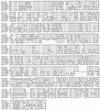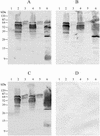Translocated intimin receptors (Tir) of Shiga-toxigenic Escherichia coli isolates belonging to serogroups O26, O111, and O157 react with sera from patients with hemolytic-uremic syndrome and exhibit marked sequence heterogeneity
- PMID: 9784578
- PMCID: PMC108704
- DOI: 10.1128/IAI.66.11.5580-5586.1998
Translocated intimin receptors (Tir) of Shiga-toxigenic Escherichia coli isolates belonging to serogroups O26, O111, and O157 react with sera from patients with hemolytic-uremic syndrome and exhibit marked sequence heterogeneity
Abstract
The capacity to form attaching and effacing (A/E) lesions on the surfaces of enterocytes is an important virulence trait of several enteric pathogens, including enteropathogenic Escherichia coli (EPEC) and Shiga-toxigenic E. coli (STEC). Formation of such lesions depends upon an interaction between a bacterial outer membrane protein (intimin) and a bacterially encoded receptor protein (Tir) which is exported from the bacterium and translocated into the host cell membrane. Intimin, Tir, and several other proteins necessary for generation of A/E lesions are encoded on a chromosomal pathogenicity island termed the locus for enterocyte effacement (LEE). Reports of sequence heterogeneity and antigenic variation in the region of intimin believed to be responsible for receptor binding raise the possibility that the receptor itself is also heterogeneous. We have examined this by cloning and sequencing tir genes from three different STEC strains belonging to serogroups O26, O111, and O157. The deduced amino acid sequences for the Tir homologues from these strains varied markedly, exhibiting only 65.4, 80.2, and 56.7% identity, respectively, to that recently reported for EPEC Tir. STEC Tir is also highly immunogenic in humans. Western blots of E. coli DH5alpha expressing the various STEC tir genes cloned in pBluescript [but not E. coli DH5alpha(pBluescript)] reacted strongly with convalescent sera from patients with hemolytic-uremic syndrome (HUS) caused by known LEE-positive STEC. Moreover, no reaction was seen when the various clone lysates were probed with serum from a patient with HUS caused by a LEE-negative STEC or with serum from a healthy individual. Covariation of exposed epitopes on both intimin and Tir may be a means whereby STEC avoid host immune responses without compromising adhesin-receptor interaction.
Figures



References
-
- Altschul S F, Gish W, Miller W, Myers E W, Lipman D J. Basic local alignment search tool. J Mol Biol. 1990;215:403–410. - PubMed
-
- Barrett T J, Kaper J B, Jerse A E, Wachsmuth I K. Virulence factors in Shiga-like toxin-producing Escherichia coli isolated from humans and cattle. J Infect Dis. 1992;165:979–980. - PubMed
-
- Beebakhee G, Louie M, De Azavedo J, Brunton J. Cloning and nucleotide sequence of the eae gene homologue from enterohemorrhagic Escherichia coli serotype O157:H7. FEMS Microbiol Lett. 1992;91:63–68. - PubMed
Publication types
MeSH terms
Substances
Associated data
- Actions
- Actions
- Actions
- Actions
LinkOut - more resources
Full Text Sources
Other Literature Sources

